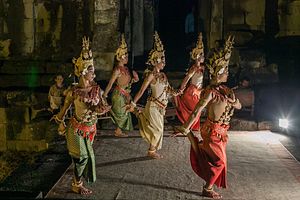“To dance in Angkor is the dream that every girl has when we start to learn Apsara Dance,” confesses Sopha, a student at one of the oldest traditional court dances in Asia. Apsara dancing, a classical style dating back to the Angkorean era, nearly vanished in the 1970s when the Khmer Rouge regime decimated much of the country’s infrastructure, culture and traditions. Almost 90 percent of Cambodia’s artists and intellectuals were systematically eliminated by the Khmer Rouge, devastating what had been a flourishing artistic community.
In recent years, however, the dance has been making a comeback in Cambodia and is now a common feature of public ceremonies and in hotel lobbies across Cambodia’s most tourist-friendly cities. Yet few people have had the opportunity to watch these incredible dancers perform in what was once their home: the Angkor temples. In these temples – where performances are held for private and exclusive dinners or for important meetings – their ancestral movements match perfectly with the mystical atmosphere that envelops the Cambodian nights.
“I am 75 years old now but I have dreamt of this moment since I was an Apsara student during the French era. I spent all of my life dedicated to dancing and it is now, when I am close to death, when I love to see that at last Cambodia is working to keep our Apsara Dance in the soul of our people forever,” says Rous Sok Khon, one of the most highly respected Apsara dance teachers in Siem Reap, where the Angkor temples can be found.
“I started dancing when I was a little girl. At that time my family was very poor, we had almost nothing to eat. With time and effort, I understood the importance of what we are doing. Thanks to women like Miss Rous Sok our country’s legacy is alive today. Her life is the example to follow for us; she is just one of the very few dancers who survived the genocide. Now I dance to show to the people how rich the history of our country is. Now I dance for Cambodia,” confesses Srey Li, one of the main dancers of Rous Sok’s group.









































